Content is from Kirkbride et al. 2006Kirkbride et al. 2006:
Kirkbride JH, Jr, Gunn CR, and Dallwitz MJ. 2006. Family guide for fruits and seeds, vers. 1.0. Accessed September 2020-January 2022. URL: https://nt.ars-grin.gov/seedsfruits/keys/frsdfam/index.cfm ., without modification.
Updates are forthcoming.
Fruits: Pistil(s) compound; 1; 1-pistillate; with carpels united. Fruit pericarpium; simple; capsulecapsule:
a dry, dehiscent fruit derived from a compound ovary ; loculicidalloculicidal:
; loculicidalloculicidal:
type of capsular dehiscence, opening longitudinally through the locules (compare septicidal)
 capsulecapsule:
capsulecapsule:
a dry, dehiscent fruit derived from a compound ovary ; capsulecapsule:
; capsulecapsule:
a dry, dehiscent fruit derived from a compound ovary not inflated; capsulecapsule:
not inflated; capsulecapsule:
a dry, dehiscent fruit derived from a compound ovary without operculumoperculum:
without operculumoperculum:
a dehiscent cap (or lid) of a seed or fruit that opens during germination or dehiscence ; without persistent central column; with styles(s); at apexapex:
; without persistent central column; with styles(s); at apexapex:
the point farthest from the point of attachment, or the "tip" of an organ ; within accessory organ(s); within perianthperianth:
; within accessory organ(s); within perianthperianth:
collective term for calyx and corolla of a flower
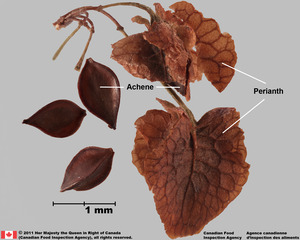 (hard), or involucreinvolucre:
(hard), or involucreinvolucre:
in the grasses, a whorl or cluster of bracts or bristles subtending a floret or spikelet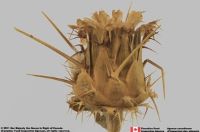 ; accrescentaccrescent:
; accrescentaccrescent:
growing continuously
; connate; more than 1 but less than 10-seeded; 4-seeded; less than 1 cm long; 0.5–0.6 cm long; with 4-carpellate; with carpels united; with carpels remaining united at maturity; with carpels not radiating at maturity; with carpels separating at stylestyle:
in a flower, the narrow and elongated part of the pistil between the stigma and the ovary; sometimes persisting in fruit ; without sterilesterile:
; without sterilesterile:
lacking male and/or female reproductive parts; also, not producing fruit or seed
 carpels; sulcatesulcate:
carpels; sulcatesulcate:
surface relief—having one or more elongate, relatively narrow and shallow depressions or grooves ; with 1 and 2-sulcate (assumed); apexapex:
; with 1 and 2-sulcate (assumed); apexapex:
the point farthest from the point of attachment, or the "tip" of an organ not beaked; dehiscentdehiscent:
not beaked; dehiscentdehiscent:
(v. dehisce) splitting open at maturity to release contents (of a fruit) . Dehiscentdehiscent:
. Dehiscentdehiscent:
(v. dehisce) splitting open at maturity to release contents (of a fruit) unit endocarp(s). Dehiscentdehiscent:
unit endocarp(s). Dehiscentdehiscent:
(v. dehisce) splitting open at maturity to release contents (of a fruit) regularly; passively (assumed); linearly; by dorsaldorsal:
regularly; passively (assumed); linearly; by dorsaldorsal:
abaxial; the back of an organ; the side away from the axis (compare ventral)
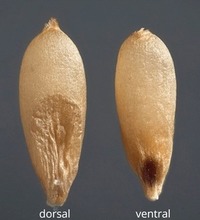 sutures; and shedding seeds; without replumreplum:
sutures; and shedding seeds; without replumreplum:
the rim, formed by the persistent placentas, and connected by a false septum in Brassicaceae fruits. The fruit valves are attached to this rim and separate from it in dehiscent fruits.
. Epicarpepicarp:
outer layer of fruit wall or pericarp, if divided into layers; note here used synonymously with exocarp dark brown (all shades); durable; without armature; with wing(s); 4-winged; with wing(s) laterallateral:
dark brown (all shades); durable; without armature; with wing(s); 4-winged; with wing(s) laterallateral:
(of embryo) embryo lies along the side of the seed, generally towards one end; of, at, or from the side; in grasses, can refer to the sides adjacent to the dorsal and ventral sides
; without apicalapical:
at or pertaining to the end of the seed or fruit distal from its point of attachment (i.e., base)
respiratory hole. Endocarpendocarp:
the inner layer of the pericarp, if divided into layers present; not separating from exocarpexocarp:
present; not separating from exocarpexocarp:
outer layer of fruit wall or pericarp, if divided into layers; note here used synonymously with epicarp ; thin; not splitting into 1-seeded pyrenes; smooth; without wing; without operculumoperculum:
; thin; not splitting into 1-seeded pyrenes; smooth; without wing; without operculumoperculum:
a dehiscent cap (or lid) of a seed or fruit that opens during germination or dehiscence ; without secretory cavities; without mechanism for seedling escape; without grooves; without longitudinallongitudinal:
; without secretory cavities; without mechanism for seedling escape; without grooves; without longitudinallongitudinal:
of or relating to length or the lengthwise dimension
ridges. Funiculusfuniculus:
(alt. funicle) stalk connecting the ovule (later seed) to the ovary (later fruit) placenta short; short without seed bearing hookswith hooks:
short; short without seed bearing hookswith hooks:
bristles or spines with curved or backwards pointing tips, or with secondary bristles along their length (retinacula); not persisting in fruit after seed shed.
(retinacula); not persisting in fruit after seed shed.
Seeds: Arilaril:
(broad sense) appendicular structure that wholly or partly envelops a seed and is produced from or a modification of the funicle, raphe, or outer integument; usually fleshy or pulpy, sometimes spongy or tufted-capillate, often brightly colored present, or absent (depending on whether it is a white funiculusfuniculus:
present, or absent (depending on whether it is a white funiculusfuniculus:
(alt. funicle) stalk connecting the ovule (later seed) to the ovary (later fruit) placenta or a carunclecaruncle:
or a carunclecaruncle:
a localized outgrowth of the seed coat near the hilum of the seed; it functions as an elaiosome ); an arillike structure. Arillike structure falling with seed a carunclecaruncle:
); an arillike structure. Arillike structure falling with seed a carunclecaruncle:
a localized outgrowth of the seed coat near the hilum of the seed; it functions as an elaiosome (some authors merely a white funiculusfuniculus:
(some authors merely a white funiculusfuniculus:
(alt. funicle) stalk connecting the ovule (later seed) to the ovary (later fruit) placenta ). Seed larger than minute; 1 to less than 5 mm long; 3.5 mm long; obovoidobovoid:
). Seed larger than minute; 1 to less than 5 mm long; 3.5 mm long; obovoidobovoid:
3D shape—obovate
and straight, or oblongoblong:
2D shape—much longer than broad with nearly parallel sides, corners are rounded , or C-shapedC-shaped:
, or C-shapedC-shaped:
2D-shape—semiannulate, curved into the shape of the letter 'C'
; in transection compressedcompressed:
flattened; in grasses, used to denote compression (not necessarily flattened) either laterally or dorsiventrally
; not bowl shaped; not nutlike; without winglike beakbeak:
a usually firm, terminal appendage, sometimes tapered ; without caudatecaudate:
; without caudatecaudate:
tapering to a long, tail-like appendage appendage(s); at maturity with food reserves; with endosperm; without canavanine. Sarcotestasarcotesta:
appendage(s); at maturity with food reserves; with endosperm; without canavanine. Sarcotestasarcotesta:
pulpy or fleshy outer layer of the seed coat, simulates aril absent. Testatesta:
absent. Testatesta:
seed coat
 present; without fleshy or leatheryleathery:
present; without fleshy or leatheryleathery:
texture—moderately thick, tough, and very pliable
layer over hard layer; tight; shinyshiny:
uniformly reflecting a high proportion of incident light at all angles ; surface unsmooth; surface with merged raised features; surface reticulatereticulate:
; surface unsmooth; surface with merged raised features; surface reticulatereticulate:
surface relief—netted, raised walls or concave grooves forming a net-like surface pattern with flat, concave, or convex interspaces ; without crease or line separating cotyledons from hypocotyl-radicle; without notch along margin where cotyledons from hypocotyl-radicle tip approach each other; without glands; without bristles; glabrousglabrous:
; without crease or line separating cotyledons from hypocotyl-radicle; without notch along margin where cotyledons from hypocotyl-radicle tip approach each other; without glands; without bristles; glabrousglabrous:
without hairs
; without wings; without collar; without operculumoperculum:
a dehiscent cap (or lid) of a seed or fruit that opens during germination or dehiscence ; colored; monochrome; thin; not becoming mucilaginousmucilaginous:
; colored; monochrome; thin; not becoming mucilaginousmucilaginous:
resembling mucilage; moist and sticky
when wetted; surrounding food reserve. Endosperm copious, or scant; fleshy; smooth; without fatty acid containing cyclopropene; without apicalapical:
at or pertaining to the end of the seed or fruit distal from its point of attachment (i.e., base)
lobes; without chlorophyll; without isodiametric faceted surface; without odor. Embryo differentiated from food reserve; well developed; 1 per seed; partially filling testatesta:
seed coat
 (with food reserve); 0.2 times the length of food reserve; at one end of seed not extending into a depression or cup; axileaxile:
(with food reserve); 0.2 times the length of food reserve; at one end of seed not extending into a depression or cup; axileaxile:
on or of the axis
and centric; conicalconical:
3D shape—cone-shaped, with the point of attachment at the broad end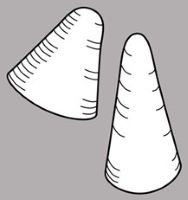 ; straight; obliqueoblique:
; straight; obliqueoblique:
in a slanting direction or position, neither horizontal nor vertical
to seed length; with cotyledons gradually connected to hypocotyl-radicle; without coleorhiza; without simmondsin; without stomata; not green; with 2 or more cotyledons. Cotyledons 2; well developed; 0.5 times length of embryo; as wide as hypocotyl-radicle; 1 times wider than hypocotyl-radicle; not concealing hypocotyl-radicle; incumbentincumbent:
(of cotyledons) having the dorsal side of one cotyledon resting against the radicle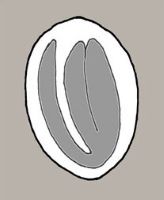 to hypocotyl-radicle; foliaceous; thin; flat; smooth; with apicesapex:
to hypocotyl-radicle; foliaceous; thin; flat; smooth; with apicesapex:
the point farthest from the point of attachment, or the "tip" of an organ entire; with margins separate; basally entire; equal in size; not punctatepunctate:
entire; with margins separate; basally entire; equal in size; not punctatepunctate:
surface relief—dotted with pits or with translucent, sunken glands or with colored dots, similar to pitted dotted. Hypocotyl-radicle moderately developed; spirally twisted; not thickened.
dotted. Hypocotyl-radicle moderately developed; spirally twisted; not thickened.
Literature specific to this family: Dahlgren, R. & V.S. Rao. 1969. A study of the family Geissolomataceae. Bot. Not. 122:207–227.
General references: Cronquist, A. 1981. An integrated system of classification of flowering plants, 1,262 p. Columbia University Press, New York, Engler, A. & K. Prantl. 1924 and onward. Die Natürlichen Pflanzenfamilimien. W. Engelman, Leipzig, Goldberg, A. 1986 (dicots) & 1989 (monocots). Classification, evolution, and phylogeny of the familes of Dicotyledons. Smithsonian Contr. Bot. 58 for dicots (314 pp.) & 71 for monocots (74 pp.). [Goldberg's illustrations are reproduced from older publications and these should be consulted], Gunn, C.R., J.H. Wiersema, C.A. Ritchie, & J.H. Kirkbride, Jr. 1992 & amendments. Families and genera of Spermatophytes recognized by the Agricultural Research Service. Techn. Bull. U.S.D.A. 1796:1–500, Mabberley, D.J. 1987. The plant-book, 706 p. Cambridge University Press, Cambridge, and Spjut, R.W. 1994. A systematic treatment of fruit types. Mem. New York Bot. Gard. 70:1–182.